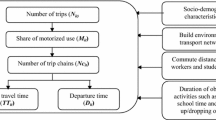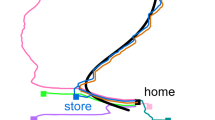Abstract
Day-to-day variability in individuals' travel behavior (intrapersonal variability) has been recognized in conceptual discussions, yet the analysis and modeling of urban travel are typically based on a single day record of each individual's travel. This paper develops and examines hypotheses regarding the determinants of intrapersonal variability in urban travel behavior.
Two general hypotheses are formulated to describe the effects of motivations for travel and related behavior and of travel and related constraints on intrapersonal variability in weekday urban travel behavior. Specific hypotheses concerning the effect of various sociodernographic characteristics on intrapersonal variability are derived from these general hypotheses. These specific hypotheses are tested empirically in the context of daily trip frequency using a five-day record of travel in Reading, England.
The empirical results support the two general hypotheses. First, individuals who have fewer economic and role-related constraints have higher levels of intrapersonal variability in their daily trip frequency. Second, individuals who fulfil personal and household needs that do not require daily participation in out-of-home activities have higher levels of intrapersonal variability in their daily trip frequency.
Similar content being viewed by others
References
Axelrod, M., “Urban Structure and Social Participation,” American Sociological Review, Vol. 21, 1956, pp 13–18.
Barnard, P.O., “Use of an Activity Diary Survey to Examine Travel and Activity Reporting in a Home Interview Survey,” Transportation, 1986.
Bonsall, P., F. Montgomery and C. Jones, “Deriving the Constancy of Traffic Flow Composition from Vehicle Registration Data,” Traffic Engineering and Control, Vol. 25, No. 7/8, 1984, pp 386–391.
Burnett, K. P., “Tests of a Linear Learning Model of Destination Choice: Application to Shopping Travel by Heterogeneous Population Groups, Geographiska Annaler, Series B, Vol. 59, 1977, pp 95–108.
Burnett, K.P. and S. Hanson, “Rationale for an Alternative Mathematical Approach to Movement as Complex Human Behavior,” Transportation Research Record, 723, 1979, pp 11–24.
Chapin, F.S., Jr., “tActivity Systems and Urban Structure: A Working Schema,” Journal of the American Institute of Planners, 1968, pp 11–18.
Chapin, F.S., Jr., Human Activity Patterns in the City: Things People Do in Time and in Space, Wiley, New York, 1974.
Chapin, F.S., Jr., “Human Time Allocation in the City,” inHuman Activity and Time Geography, T. Carlstein, D. Parkes and N. Thrift (eds.), Wiley and Sons, New York, 1978.
Downes, J. D. and R. Wroot, 1971 Repeat Survey of Travel in the Reading Area, Department of the Environment, TRRL SR 43 UC, Crowthorne, England, 1974.
Fuller, W. A. and G. E. Battese, “Estimation of Linear Models with Crossed-Error Structure,” Journal of Econometrics, Vol. 2, 1974, pp 67–78.
Golledge, R., “Some Equilibrium Models of Consumer Behavior,” Economic Geography, Vol. 46, 1970, pp 417–424.
Golob, T. F. and H. Meurs, “Biases in Response Over Time in a Seven-Day Travel Diary,” Transportation, 1986.
Hagerstrand, T., “What About People in Regional Science?” Papers and Proceedings of the Regional Science Association, Vol. 24, 1970, pp 7–24.
Hagerstrand, T., The Impact of Transport on the Quality of Life, Fifth International Symposium on Theory and Practice in Tansport Economics, Greece, October 1973.
Heggie, I.G., “Putting Behavior into Behavioral Models of Travel Choice,” Journal of Operational Research Society, 29, 1978, pp 541–550.
Herz, R., “Stability, Variability, and Flexibility in Every Day Behavior,” in Recent Advances in Travel Demand Analysis, Carpenter, S. and P. Jones (eds.) Gower Publishing Company, Aldershot, England, 1983, pp 385–400.
Hodge, R.W. and D.J. Treiman, “Social Participation and Social Status,” American Sociological Review, Vol. 33, No. 5, 1968, pp 722–739.
Huff, J. O. and S. Hanson, “Repetition and Variability in Urban Travel,” Manuscript in Publication Review, 1985.
Marble, D.F. and S.R. Bowlby, “Shopping Alternatives and Recurrent Travel Patterns,” in Geographic Studies of Urban Transportation and Network Analysis, F.E. Horton (ed.), Northwestern University Press, Evanston, IL., 1968.
Mitchell, R.B. and J.C. Rapkin, Urban Traffic A Function of Land Use, Columbia University Press, New York, 1954.
Oi, W.Y. and P.W. Shuldiner, An Analysis of Urban Travel Demands, Northwestern University Press, Evanston, Illinois, 1962.
Pas, E. I., “Are We Too Severe in Assessing the Goodness-of-Fit of Travel Demand Models?” Manuscript in review, 1985.
Pas, E.I., “Multiday Samples, Parameter Estimation Precision and Data Collection Costs for Least Squares Regression Trip Generation Models,” Environment and Planning A, to appear, 1986.
Pas, E.I. and F.S. Koppelman, “Comparative Analysis of the Transferability of Disaggregate Automobile Ownership and Mode Choice Models,” Transportation Research Record, 1984, pp 40–48.
Reichman, S., “Travel Adjustments and Lifestyles — A Behavioral Approach” in Behavioral Travel Demand Models, Stopher, P.R. and A.H. Meyburg (eds.), Lexington Books, Lexington, Massachusetts, 1976, pp 143–152.
Reisman, L., “Class, Leisure and Social Participation,” American Sociological Review, Vol. 19, no. 1, 1954, pp 76–84.
Shapcott, M., “Comparison of the Use of Time in Reading, England with Time Use in Other Countries,” Transactions of the Martin Centre for Architectural and Urban Studies, Vol. 3, 1978, pp 231–257.
Shapcott, M. and P. Steadman, “Rythms of Urban Activity,” in Human Activity and Time Geography, T. Carlstein, D. Parkes and N. Thrift (eds.), Wiley and Sons, New York, 1978.
Author information
Authors and Affiliations
Rights and permissions
About this article
Cite this article
Pas, E.I., Koppelman, F.S. An examination of the determinants of day-to-day variability in individuals' urban travel behavior. Transportation 14, 3–20 (1987). https://doi.org/10.1007/BF00172463
Issue Date:
DOI: https://doi.org/10.1007/BF00172463




